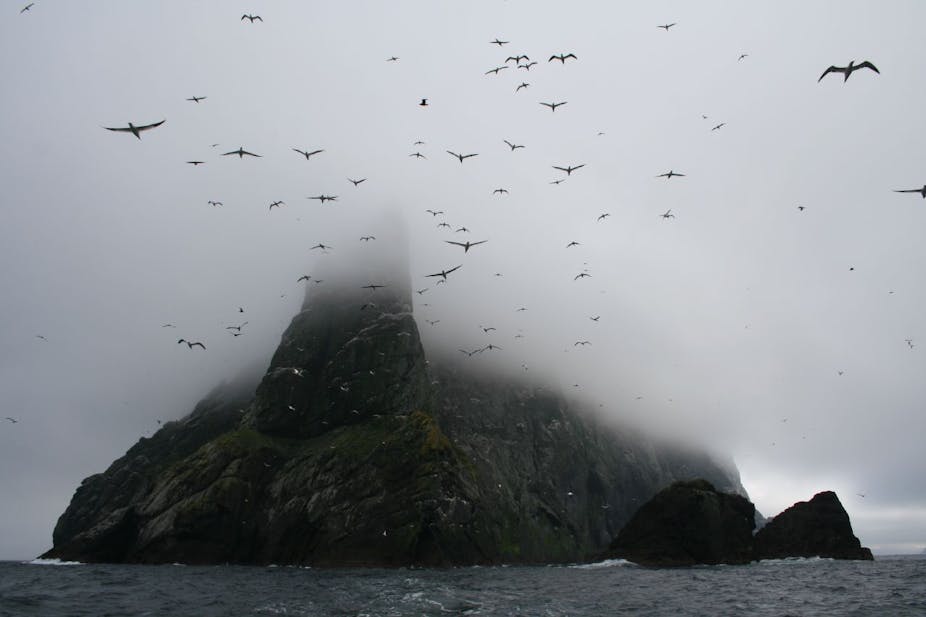Scotland is renowned for its seabirds, thanks to landmarks such as the Bass Rock, Ailsa Craig and St Kilda. There are around five million of the birds, including 95% of the EU’s great skuas, 67% of its northern gannets and 65% of its black-legged kittiwakes.
But numbers are declining fast, with shortages of prey and habitat problems conspiring to affect the birds’ breeding success. According to a new RSPB report commissioned by the Scottish government, the declines date back as far as 1986. They have been greatest for Arctic skua (an 80% drop), Arctic tern (72%) and black-legged kittiwake (68%).
Under the European birds directive, member states have a duty to protect habitats for the conservation of birds, including developing special protected areas. Although these areas already exist for seabird colonies on land, the RSPB urgently wants seven designated areas for birds at sea. In time it also wants the Scottish government to designate a separate set of marine protected areas to protect seabird foraging grounds.
While protected areas on land are beneficial, they only protect a limited proportion of the seabird’s life cycle. A recent ecological modelling study found that seabirds’ success at breeding is affected by the availability and quality of their prey.
Having protected areas at sea that include foraging areas may therefore protect seabird populations and boost their resilience. The sites proposed for the new special protected areas include the inner and outer sandbanks of the Firth of Forth; an area of the Pentland Firth; and the seas around Foula, Shetland.

Pressures on seabirds
The fall in bird populations is possibly being exacerbated by human activities at sea. People have long affected seabird populations in this way, but the variety of pressures has increased in recent years. The recent proposals for marine renewable energy developments, particularly wind but also wave and tidal, are often seen as yet another potential threat to seabirds that may be hard to justify when numbers are already falling.
Admittedly it is hard to separate the effect of marine renewable energy from other effects, particularly climate change. Much effort is being put into designing research and monitoring studies that can give us a clearer picture here. A group of scientists, civil servants and NGOs from around the globe recently met in Stornoway to discuss these issues.
Whatever the case, climate change certainly seems to be causing problems. Increased storminess is affecting bird populations, for example. In recent years we have seen huge wrecks of seabirds, with record numbers washed up dead or injured on beaches.
Scientists have also drawn a link between climate change, rising sea temperatures and shifting fish distributions, both for seabird prey species such as sandeels and larger species. A recent study documented bluefin tuna in high latitute sub-polar waters far beyond their usual habitat. It is not known how well seabirds will cope with these changes, especially during the breeding season when they are tied to a nest.

At the same time, the birds are also competing with commercial fisheries over these increasingly limited fish stocks. One problem to have made news recently is fishing boats discarding their catches. Whatever the positives of banning the practice, it is not good news for scavenger seabirds.
Plastic problem
Another threat to the birds is our addiction to plastic. On top of well known concerns about the likes of shopping bags and food wrappers, microplastics have been shown to be present, in the form of microbeads, in shower gels, face washes, toothpaste and cleaning products. These microbeads are too small to be filtered by most water treatment plants and find their way into lakes and rivers and eventually the marine environment.
We are yet to fully understand the consequences of wildlife consuming plastics, but a recent four-year study by the University of Tasmania examined their toxic effects to seabirds. It found that the amounts of plastic being ingested by the birds increased during the study, and that it undermined their body condition and apparently also the chances of their chicks reaching adulthood.

All these seaborne problems lie behind the RSPB’s call for protected areas offshore. To get the best out of the strategy, it is essential that we have a good understanding of not only which areas are important for seabirds but also why. In this regard, there is still much we don’t know. Seabird tracking projects such as the RSPB’s FAME project will be key to understanding how oceanography and habitat influence seabird distributions.
We should also be mindful that seabird foraging areas may change in future depending on how climate change affects things like fish distributions. This might mean we have to change protected areas accordingly, so any network of areas needs to be flexible to ensure it fully protects the seabirds it is set to serve.
And finally, a carrot …
The Scottish government has a legal obligation to protect seabirds, but is it not of national interest to actually have thriving populations? A recent study on the economic impact of wildlife tourism in Scotland commissioned by the Scottish government found that the net economic impact in Scotland due to wildlife tourism was £65 million, with many of the businesses focusing on seabirds.
The economic impact was also highest in the more rural Highlands and Islands region, an area that could certainly do with the boost. Put together with the legal and conservational rationales, this is one more reason why the RSPB’s proposals ought to lead to government action.

